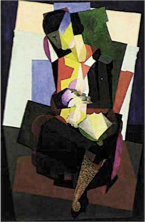
Diego Rivera: The Cubist Portraits, 1913-1917, the Meadows Museum of Art, through September 20, 2009
Diego Rivera spent some of his most formative creative years in Europe, studying, creating and absorbing the variety of culture around him. After two productive years in Spain, he arrived in Paris at the dawn of Cubism. At 22 years old, he stood at the precipice of his own creative development as well as that of the avant-garde. The work that he produced during this time period is extraordinary. Unlike most of the Cubists, including Picasso, he retained the figure while fragmenting the picture plane both around it and within it. His subjects tended to be other members of Paris‘ thriving, mostly foreign contemporary art scene. These include his close friend Jacques Lipschitz, sculptor Oscar Miestchaninoff, painter Frank B. Haviland, writer Ilya Ehrenburg as well as the portraits of his first wife, Angelina Beloff, and his mistress, Marevna. His Sailor at Lunch, painted early into his foray with Cubism, is a tour de force.
The exhibition works on multiple layers. It chronicles the time and place in which Rivera found himself and also sheds new light on Cubism. The colors are bright and spectacular which, in my opinion, is a welcome change from Picasso’s more monochromatic palettes. And the textures! Rivera spent World War I on Majorca with Beloff. It was here that he experimented with sand and wood in his work. While the portraits in the exhibition are straight oils, there is a textural element to many of them that enhances their dynamism.
While we tend to think of Rivera exclusively as a Mexican artist of Mexican subject matter, it is interesting to note that his Cubist work was well received in Paris and provided him with financial security. Two events pushed him away from the movement: a falling out with Picasso, in which Picasso accused him of plagiarism, and what came to be know as “l’affaire Rivera”. In 1917, Pierre Reverdy wrote, “Sur le Cubisme” roundly denouncing Cubist portraiture. Even without naming names, everyone in Parisian artistic circles knew he was referring to Rivera. For his part, Rivera turned forever away from Cubism and from most of his longtime friends that he associated with it. The movement was on the wane regardless and Rivera remade himself as the great muralist for which he is famous. But the body of paintings he did during this time is such good work. It would have been interesting to see where it would have led him had he stayed attached to the avant garde movements sweeping through Paris during the first half of the last century.
